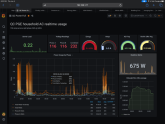Hi.There are so many of the MPP all in one models with variations, I am a little lost. Waiting to hear back from MPP Solar but would love some input here on the forum.
Trying to build a 5kWh off-grid system. Will be connecting 2 of the 24V in series LiFePO4 Powerwalls which are 3kWh each.
Just don't know for sure which MPP solar model is the best way to go? I am quite new at this. Looking at either 2 of these PIP 3048LV -MK X2 models wired together in parallel which gives 6KWh 48V or at Will Prowse's suggestion on his site, an LV5048 which is 5kWh at 48V. The reason I was considering the two units in parallel was that the cost is about the same and it looks like I get an extra 1kWh.
But honestly, there are so many variables here that I want to make sure I am covering my bases.
If you have any suggestions, by all means, they are welcome.
Also, I am wondering, do I just plug in a power strip into this inverter to get enough AC outlets? I am moving into a cabin that has no internal wiring or outlets (yet), and until that is done, I am going to need to power a bunch of things via AC.
Thanks!
Trying to build a 5kWh off-grid system. Will be connecting 2 of the 24V in series LiFePO4 Powerwalls which are 3kWh each.
Just don't know for sure which MPP solar model is the best way to go? I am quite new at this. Looking at either 2 of these PIP 3048LV -MK X2 models wired together in parallel which gives 6KWh 48V or at Will Prowse's suggestion on his site, an LV5048 which is 5kWh at 48V. The reason I was considering the two units in parallel was that the cost is about the same and it looks like I get an extra 1kWh.
But honestly, there are so many variables here that I want to make sure I am covering my bases.
If you have any suggestions, by all means, they are welcome.
Also, I am wondering, do I just plug in a power strip into this inverter to get enough AC outlets? I am moving into a cabin that has no internal wiring or outlets (yet), and until that is done, I am going to need to power a bunch of things via AC.
Thanks!




